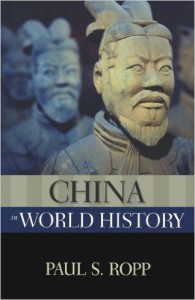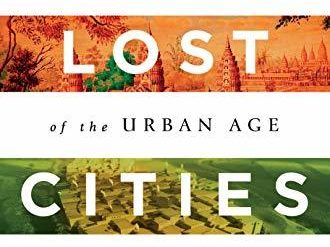
Far too few Americans are familiar with even the outlines of China’s 3,500-year history. We may have learned a few isolated facts — for instance, that gunpowder, paper money, and printing were all invented in China — but we’re largely unaware of the intellectual and political currents that form a backdrop for Chinese behavior to the present day. Our country is paying the price of that ignorance in the difficulty we face in dealing with China as a reemerging world power. It may be tempting, then, to dip into this little book of Chinese history encompassing 3,500 years.
Estimated reading time: 3 minutes
Chinese history in a nutshell
In China in World History, Paul S. Ropp set out to condense the history of the world’s largest nation within less than 200 pages. At the outset, he makes his case: “An identifiable and sophisticated Chinese culture emerged by 1500 bce and has shown remarkable continuity in its language, cultural values, and social and political organization over the past three and a half millennia.” While this may be the view from 30,000 feet, and no doubt that judgment applies to China’s still-backward rural areas, I strongly suspect that the perspective of the hundreds of millions of Chinese who live in cities might well be different. It’s difficult to see all that continuity in the soaring highrises of China’s newly built cities and their Westernized youth culture.
China in World History by Paul S. Ropp (2010) 206 pages ★★★☆☆
Undoubtedly, China faces the world with critical advantages: a written language that spans numerous mutually unintelligible languages and dialects; an acceptance of “the world and human existence as facts of life that needed no supernatural explanation or divine creator;” and a contiguous landmass advantageously situated to command much of the Asian continent. Together, these facts help account for the reality that, except for the nineteenth and twentieth centuries, China was the world’s most advanced and prosperous nation throughout its 3,500-year history.
It’s too easy for Westerners to lose sight of that fact. Only with the advent of the Industrial Revolution late in the eighteenth century did the tables turn. Ropp calls it “a cruel coincidence of history that Qing dynasty decline coincided precisely” with the surge in wealth and power that shifted to the West. In other words, had its leadership not been so corrupt and incompetent, even during the past two centuries China might well have maintained its planetary leadership.
“One damn dynasty after another”
According to its editors, the New Oxford World History series “presents local histories in a global context and gives an overview of world events seen through the eyes of ordinary people.” Disappointingly, Paul S. Ropp’s entry in the series, China in World History, fails to meet this standard. Although the author ventures into social history on occasion, and he pays due diligence to the intellectual and religious currents in the country’s history, most of the book is a recitation of one damn dynasty after another. We’re treated to a seemingly endless list of emperors, broken from time to time with the names of scholars or religious leaders, with “ordinary people” nowhere to be found.
About the author
Paul S. Ropp retired from the faculty of Clark University in 2011. He is a specialist in Chinese history.
For related reading
This is one of 20 insightful books about China.
You may enjoy browsing through 20 top nonfiction books about history.
If you enjoy reading history in fictional form, check out 20 most enlightening historical novels.
And if you’re looking for a broader view of human history, check out New perspectives on world history.
And you can always find my most popular reviews, and the most recent ones, on the Home Page.



























